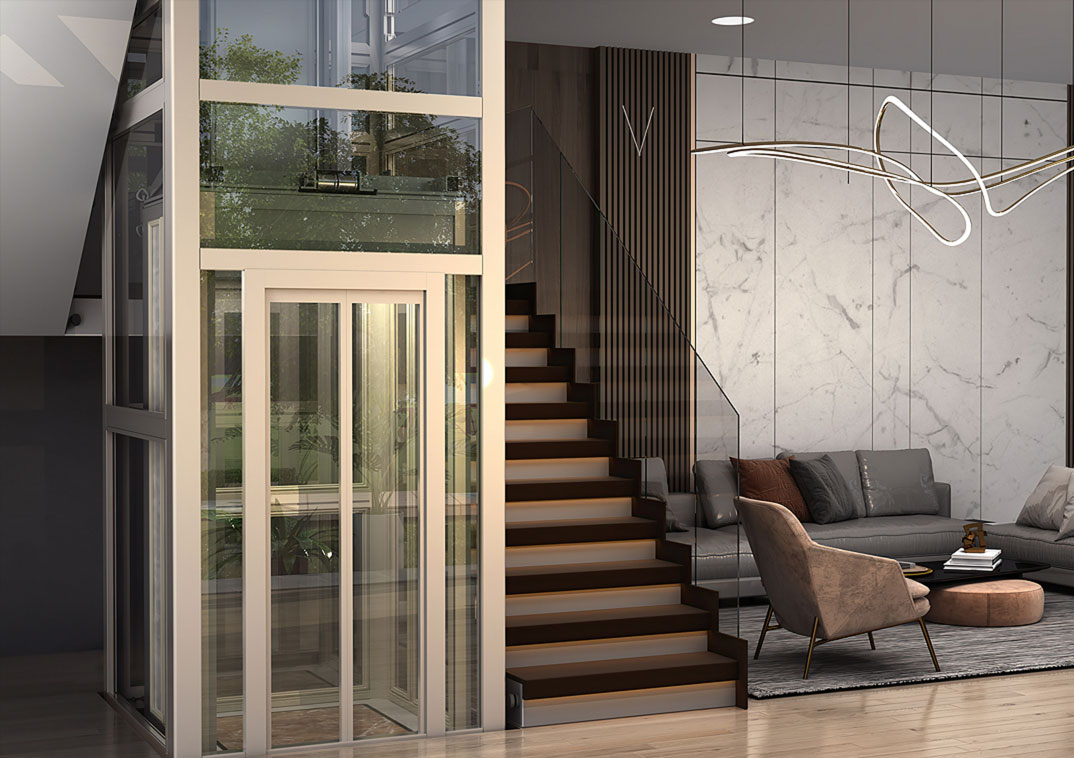The durability and material selection of Villa Elevators are key factors in ensuring long-term smooth and safe operation of the elevator. Since villa elevators are usually designed for high-end residences, their durability and material selection must not only meet the needs of daily use, but also take into account aesthetics, comfort and long-term reliability. The following are several key requirements for the durability and material selection of villa elevators:
Strength and durability of structural materials
Steel: Steel is a common main material in villa elevator structures, especially the frame and support system of the elevator. Choosing high-strength, corrosion-resistant steel can ensure that the elevator can withstand long-term loads without deformation or damage. For example, the use of stainless steel materials can improve the durability of the elevator and prevent corrosion and rust, especially in humid environments.
Aluminum alloy: Aluminum alloy materials are widely used in non-load-bearing parts such as elevator casings and door panels due to their light weight, strong corrosion resistance, smooth surface and beautiful appearance. Its durability and beauty make it very popular in villa elevators.
Stainless steel: Stainless steel not only provides excellent corrosion resistance, but also has high strength and durability, so it is often used in elevator interiors and load-bearing parts, such as elevator doors and frames inside elevators. Especially in coastal cities, where the air has a high salt content, stainless steel can effectively prevent corrosion.
Corrosion resistance and rust-proof design
Surface treatment technology: In order to improve the durability of the elevator structure, especially in humid environments, the metal parts of the elevator need to undergo special surface treatment, such as hot-dip galvanizing, electroplating or plastic spraying. Through these treatment methods, metal rust and corrosion can be effectively prevented, extending the service life of the elevator.
Waterproof sealing: Waterproof sealing needs to be considered when designing villa elevators, especially if the elevator is installed in a basement or an environment susceptible to moisture. The design of the elevator's electrical system, control panel and elevator shaft should have good waterproof performance to avoid moisture from damaging the elevator system.
Material selection for elevator interiors

High-quality wood: In high-end villa elevators, the choice of interiors is crucial. Solid wood or high-quality wood (such as oak, walnut, etc.) is used for elevator interior decoration, which not only improves the aesthetics, but also enhances the warmth and comfort of the elevator. The wood surface needs to undergo strict moisture-proof and fire-proof treatment to ensure its durability.
Glass: Transparent or frosted glass is often used in the exterior design of elevators, especially in transparent elevator designs. Glass not only provides visual comfort, but also effectively improves the sense of space and aesthetics of the elevator. The use of safety tempered glass or laminated glass can ensure that the glass will not cause harm to passengers when it breaks, and has good impact resistance.
Fireproof materials: All interior materials must meet fire resistance standards, especially in the interior design of villa elevators, the fire resistance of wood and cloth materials is crucial. The use of fireproof panels, flame retardant coatings, etc. can effectively improve the safety of the elevator.
Durability of elevator mechanical parts
Elevator wire rope: Wire rope is an important component of elevator lifting. It is very important to choose wear-resistant and high-tensile strength wire rope. Durable wire rope can effectively reduce the frequency of failures and maintenance and ensure the smooth operation of the elevator.
Motor and drive system: The motor and drive system of the elevator need to have high efficiency and durability. Usually, high-performance, low-power motors and drive devices that can run stably for a long time are selected. Efficient motors not only reduce energy consumption, but also increase the service life of the elevator.
Anti-seismic and shock-absorbing design
Villa elevators usually need to deal with a certain degree of vibration, especially in the use of multi-story villas. By choosing high-quality shock-absorbing materials, such as rubber shock-absorbing pads, spring shock-absorbing devices, etc., the noise and vibration during elevator operation can be effectively reduced, and the mechanical life of the elevator can be extended.
In the base and rail parts of the elevator, the use of anti-seismic design and precise machining can reduce the friction and wear between the elevator components and keep the elevator running smoothly.
Durability of elevator doors and safety devices
Door panel materials: The door panels of villa elevators should not only have a beautiful appearance, but also be durable and safe. Commonly used materials include stainless steel, aluminum alloy, tempered glass, etc. The door panel design should be able to withstand frequent opening and closing without deformation.
Safety devices: The safety devices of villa elevators should have high durability, such as anti-pinch devices, overload protection, access control systems, etc. All safety equipment must pass strict quality inspections to ensure that the elevator can be protected in time when a failure occurs.
Environmentally friendly and sustainable materials
The design of modern villa elevators pays more and more attention to environmental protection and sustainability. Choosing low-VOC (volatile organic compound) materials, recycled materials, and paints and coatings that meet environmental standards can make the elevator not only have superior performance, but also meet the requirements of green buildings.
When designing and selecting materials for villa elevators, the strength, durability, safety, aesthetics and environmental protection of the elevator must be comprehensively considered. Selecting high-strength, corrosion-resistant and anti-aging materials, and performing precise processing and surface treatment, is the key to ensuring the long-term stable operation of the elevator. Moreover, the material selection of villa elevators not only affects its durability, but also affects the safety and comfort of passengers, so it is necessary to be particularly cautious when choosing.











